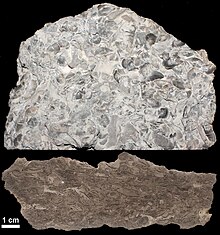Kope Formation
| Kope Formation Stratigraphic range: Late Ordovician (Edenian Stage) |
|
|---|---|

Photograph and etched section of hand sample of limestone of Kope Formation. Brachiopods and Bryozoans visible.
|
|
| Type | sedimentary |
| Unit of | Maquoketa Group (in Indiana) |
| Sub-units | Grand Avenue Member, Wesselman Tongue |
| Underlies | Fairview Formation |
| Overlies | Point Pleasant Formation |
| Lithology | |
| Primary | Limestone |
| Other | shale |
| Location | |
| Region | Cincinnati Arch of North America |
| Extent | Kentucky, Ohio, Indiana |
The Kope Formation is one of the three component bedrock formations of the Maquoketa Group that primarily consists of shale (75%) with some limestone (25%) interbedded. In general, it has a bluish-gray color that weathers light gray to yellowish-gray and it occurs in northern Kentucky, southwest Ohio, and southeast Indiana, United States.
The depositional environment of the Kope was shallow marine. The central North American continent was a tropical epeiric sea at the time.
Jennette and Pryor (1993) interpret the Kope, along with the Bellevue and Fairview formations, as a progradational succession on a carbonate ramp. The Kope is the most distal facies of the ramp complex.
The type section of the Grand Avenue Member is a cliff to the west of Grand Avenue in Cincinnati, Hamilton County, Ohio.
The type section of the Wesselman Tongue of the Kope formation is an east-facing embankment on an unnamed creek that is followed by Wesselman Road in Miami Township, Hamilton County, Ohio. The embankment is 400 ft south of Zion Hill bridge.
Brachiopods, trilobites, bryozoans, rugose corals, and echinoderms (including crinoids, asteroids, and edrioasteroids) are all present in the Kope. Due to their mid-continent depositional environment, the fossils are almost free of deformation caused by tectonic activity common in the Appalachian Mountains.
The brachiopods Dalmanella sp., Hebertella sp., Leptaena sp., Petrocrania sp., Philhedra sp., Platystrophia sp., Pseudolingula sp., Rafinesquina sp., Sowerbyella sp., Strophomena sp., Trematis sp., and Zygospira sp. have been recorded from the Cincinnatian Series, which includes the Kope Formation.
...
Wikipedia
